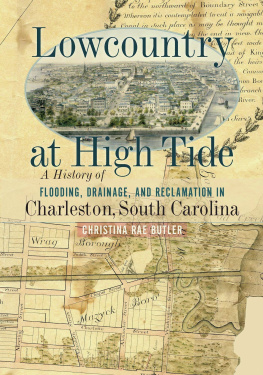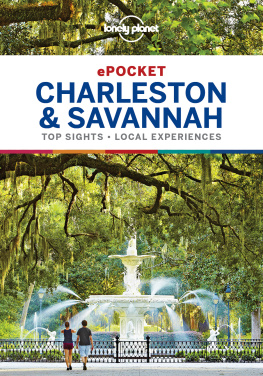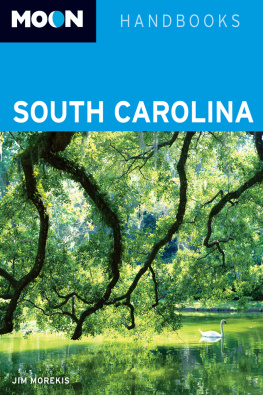The Travelers Charleston
The Travelers
Charleston
Accounts of Charleston and
Lowcountry, South Carolina,
16661861
EDITED BY
Jennie Holton Fant
2016 University of South Carolina
Published by the University of South Carolina Press
Columbia, South Carolina 29208
www.sc.edu/uscpress
25 24 23 22 21 20 19 18 17 16
10 9 8 7 6 5 4 3 2 1
Library of Congress Cataloging-in-Publication Data
can be found at http://catalog.loc.gov/
ISBN 978-1-61117-584-4 (cloth)
ISBN 978-1-61117-585-1 (ebook)
Front cover illustration by Brock Henderson
CONTENTS
LIST OF ILLUSTRATIONS
ACKNOWLEDGMENTS
I have incurred many debts of gratitude in the research and preparation of this manuscript with its combination of letters, documents, and illustrations. I owe special thanks to my editor, Alexander Moore at the University of South Carolina Press, who accompanied me on this long journey to publication, and to whom I am infinitely grateful for his support, his expertise, and his belief in this book. The research for this volume would not have been possible without the faculty library privileges I was granted as an employee of Duke University Libraries, with its wonderful resources. I am infinitely grateful to the staff of Interlibrary Loan at Duke Libraries, who, over a number of years, granted my fathoms of requests for materials in and beyond the university, some relatively obscure. I am further indebted to Interlibrary Loan at Durham County Library, Shannon Road, for granting my many requests as well.
I owe appreciation to the William L. Clements Library at the University of Michigan for permission to publish the Joseph Woory 1666 account. My gratitude to the Massachusetts Historical Society for permission to reproduce a portion of the original journal of Josiah Quincy Jr. from the Quincy Family Papers. During the research for this book, the Library of Congress digitized the handwritten correspondence of Samuel F. B. Morse. My appreciation to them for permission to publish a number of letters written to and from Morse while he was in Charleston between 1818 and 1821. My sincere gratitude to Michael Mallon, literary executor of the Sir John Pope-Hennessy estate, for permission to publish from the original letters of Margaret Hunter Hall. Additional thanks to Mallons literary agent and agency, Darryl Samaraweera and Artellus Ltd. in London for help locating Mr. Mallon in Paris. Further, I am indebted to Catherine Wilson, great-great-granddaughter of William Makepeace Thackeray, for her kind guidance through the various rights of the Thackeray estates in my quest to obtain permission to reprint a number of the Thackeray letters first published by Gordon N. Ray some years ago.
My deep appreciation goes to staff members of innumerable libraries, archives, and museums: Michelle Gait at the Special Collections Centre, the Sir Duncan Rice Library, Aberdeen University; Jamie Cutts at Aberdeenshire Council, Aberdeenshire Museums Service; Ondine LeBlanc, Elaine Heavey and Anna Clutterbuck-Cook at the Massachusetts Historical Society, Boston; Jennifer Johns at Ruthmere Museum, Elkhart, Indiana; Dale Sauter at Manuscripts and Rare Books, Joyner Library, East Carolina University; Jeffery Flannery and Lewis Wyman at the Manuscripts Division, Library of Congress; Mrta Fodor at the Museum of Fine Arts, Boston; Alice Hickcox at the Beck Center, Emory University Libraries; Diana Sykes at the William L. Clements Library, University of Michigan. My added thanks to the National Portrait Gallery, London; Victoria and Albert Museum; National Library of Scotland; New-York Historical Society; Library of Congress Prints and Photographs; Thomas Cooper Library, University of South Carolina; United States Office of Medical History; and the National Library of Medicine.
Finally, my love and gratitude to friends and family who supported me over the long gestation of this project, especially Rhet Wilson-Deehan and John Deehan, Eleanor Hawkins and Mary Cecil Hawkins Parker. I salute your long-suffering belief that one day this tome would, indeed, make it to the reader. My regard to the many friends (you know who you are) who tolerated my long sequester; nevertheless, at every stage in the preparation for this book showed such interest. I further owe a debt of gratitude to my friend and excellent on-call IT resource, James Wood, a genius with technology.
INTRODUCTION
These charming gardens, in connection with the piazzas resting on ornamental pillars, make the whole town graceful. One sits, in the morning, in these open chambers, inhaling the refreshing air from the sea, its perfume mingled with that of the flowers below; and, at midday, closing the Venetian shutters to exclude the sun, he rests in grateful shade. Here, too, throughout the longer portion of the year, may be spread, at evening, the tea table; while the heavens still glow with the purple-and amber of the sunset. And here lingers the family until the bells from the tower of St. Michaels, sweetly ringing their silver chimes through the calm, starry air, announce, at last, the hour of repose.
John Milton Mackie, From Cape Cod to
Dixie and the Tropics, 1864
Soon after he was restored to the English throne in 1660, King Charles II rewarded eight men who had supported him in exile with a large section of the American continent. These men, constituted lords proprietors, were granted the province of Carolina by a charter dated 1663, which gave them permission to develop all that territory, or tract of ground called Carolina scituate, lying, and being within our dominions of America. Carolina extended over a vast and unexplored terrain from Virginia to Florida.
Five months later, a group of Barbados businessmen sponsored an expedition to explore the coastal regions of the grant. Commanded by Captain William Hilton, the expedition left Barbados in August of 1663 and arrived in the province of Carolina. They sailed in the proximity of the Combahee and Edisto rivers, Port Royal, and St. Helena Sound. In a report, Hilton described the region as one of the greatest and fairest havens in the world.
Influenced by Captain Hiltons favorable description, at the end of 1663 a second English group set out from Barbados to settle an area on the Charles River (later named the Clarendon River, now the Cape Fear River), which they named Charles Town. When that colony proved unsuccessful, the lords proprietors encouraged the Barbadians to explore the territory further south for settlement, that region described by Hilton. An expedition ensued in two small vessels, the Speedwell and the Rebecca, commanded by Lieutenant-Colonel Robert Sandford.
It is here that this book beginswith an account written four years before Charles Town was founded in what is now South Carolina. The Sandford expedition set out on June 16, 1666, and explored down to Beaufort (Port Royal). Lieutenant Joseph Woory, a crewman aboard, wrote an account of the discovery of these coastal regions. As a result of this sighting by Sandford and his crew, Port Royal became the original destination for ships carrying the first settlers of Charles Town in 1670. They arrived near Beaufort only to be convinced by Kiawah Indians that the territory around what is now Charleston was a better choice for farming, and realized it was (thankfully) even further away from the Spanish settlement of St. Augustine.








